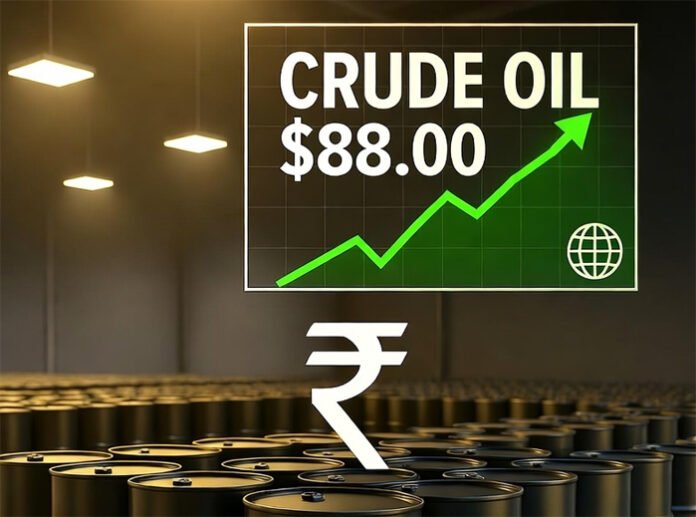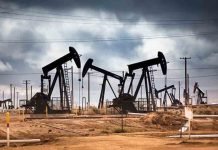New Delhi, October 29, 2025:
Crude oil prices climbed for the third consecutive day on Wednesday, driven by supply concerns and geopolitical tensions in the Middle East. Brent crude traded near $88.40 per barrel, while WTI hovered around $84.15, marking a week-high level.
For a country like India — which imports nearly 85% of its oil needs — rising crude prices have direct and far-reaching consequences, from petrol and diesel rates to inflation and currency fluctuations.
“The current uptrend in global crude prices will test India’s import bill. Every $1 rise in crude increases the country’s oil import bill by nearly ₹11,000 crore annually,” explained Suhas Joshi, Senior Economist at Kotak Research.
⚖️ Why Are Oil Prices Rising Again?
Analysts point to a mix of geopolitical and economic factors driving the surge:
Renewed tensions in the Middle East have raised supply concerns.
OPEC+ hinted at possible production cuts to stabilize prices.
Signs of global demand recovery, especially in Asia, have supported the market.
The U.S. Federal Reserve’s rate pause has weakened the dollar slightly, lifting commodities.
“Crude is balancing between global recovery optimism and supply risk. If OPEC sticks to its production cap, prices could stay around $90 for the next quarter,” said Ritika Mehra, Energy Analyst at ICICI Direct.
🇮🇳 Impact on India: The Ripple Effect
The rising oil prices directly impact India’s current account deficit, rupee exchange rate, and inflation outlook.
1️⃣ 🛢️ Import Bill Surge:
India spends nearly $190 billion annually on crude imports. Any rise in global oil prices immediately widens the trade deficit.
2️⃣ 💸 Rupee Depreciation:
The rupee slipped to ₹88.29 per USD today — its weakest level in two weeks — as traders priced in higher dollar demand from oil importers.
3️⃣ 💹 Inflation Pressure:
Fuel prices affect transport costs and food inflation. Economists expect October CPI to rise marginally due to cost-push effects.
“Rising crude remains a double-edged sword — it benefits ONGC and Reliance but hurts consumer inflation,” noted Anil Reddy, Macro Strategist at HDFC Securities.
⛽ Will Petrol and Diesel Prices Rise?
For now, oil marketing companies have kept retail fuel prices unchanged, but if crude remains above $88–$90, experts say there could be a ₹1–₹2 per litre hike in November.
“Oil firms have been absorbing some costs post-election season. With rising global prices, a revision may be imminent,” said Ravi Sinha, a commodities market watcher.
Across major metros, current fuel prices are:
Delhi: Petrol ₹103.62 | Diesel ₹89.42
Mumbai: Petrol ₹109.89 | Diesel ₹94.14
Bengaluru: Petrol ₹104.12 | Diesel ₹89.85
💼 Winners & Losers: Who Gains From Rising Oil?
✅ Winners:
Oil explorers (ONGC, Oil India) gain from higher crude realizations.
Energy services and refinery companies enjoy better margins.
❌ Losers:
Aviation, paints, and logistics sectors face rising input costs.
Consumers may see a hit on disposable income as inflation rises.
“If crude remains elevated beyond $90 for long, consumer spending could slow in Q4,” warned Mehra.
🏦 Government’s Balancing Act
The government may face fiscal challenges if it has to cut excise duties to keep fuel affordable. However, strong GST collections and robust tax revenues provide some cushion.
Policymakers are also exploring long-term crude purchase agreements with Russia and UAE to diversify supply and reduce volatility.
“India is better hedged than in 2012 or 2018 — but any prolonged price spike still hurts the fiscal math,” said K. Subramanian, former Chief Economic Advisor.
📊 Global Oil Market Outlook
Oil prices are expected to remain range-bound between $85–$90 per barrel in the near term.
With demand from Asia strong and OPEC+ likely to maintain supply discipline, analysts don’t foresee a major correction soon.
“The oil market is entering a consolidation phase. Volatility may rise, but average prices will likely remain elevated,” added Reddy.
💬 What Investors Should Watch
Monitor crude price trends and RBI commentary on inflation.
Track energy stock movements — ONGC, IOC, and BPCL could benefit.
Stay cautious with aviation and logistics stocks in the short term.
“Energy is a key driver for inflation and currency. For investors, it’s both an opportunity and a risk,” summarized Joshi.
🧭 Bottom Line: Energy Costs Are Back in Focus
As crude oil climbs closer to $90, India’s policymakers and consumers are watching closely.
While exporters and refiners may celebrate, the broader economy braces for higher costs.
The takeaway? If oil prices continue this rally, India may need to walk a fine line — balancing growth, inflation, and fiscal prudence.
“Oil is the heartbeat of the Indian economy. When it spikes, everyone feels the pulse,” concluded Mehra.















